How Many Pages of Text Is 30 Min Reading Aloud
This is the second entry in the Education Leader's Guide to Reading Growth, a 7-part series about the relationship between reading practice, reading growth, and overall student accomplishment.
In our last post, we examined how reading practice characteristics differ between persistently struggling students and students who start out struggling but end up succeeding—and how stiff reading skills are linked to high school graduation rates and college enrollment rates.
However, information technology'south not only struggling readers who could do good from more reading practice. A study of the reading practices of more than than 9.ix one thousand thousand students over the 2015–2016 school year plant that more half of the students read less than 15 minutes per twenty-four hours on boilerplate.ane

Fewer than ane in five students averaged a half-60 minutes or more of reading per mean solar day, and fewer than i in 3 read between 15 and 29 minutes on a daily basis.

The trouble is that 15 minutes seems to be the "magic number" at which students commencement seeing substantial positive gains in reading achievement, yet less than one-half of our students are reading for that amount of fourth dimension.
15 minutes seems to be the "magic number" at which students start seeing substantial positive gains in reading accomplishment; students who read merely over a half-hour to an hour per day see the greatest gains of all.
An assay comparison the engaged reading time and reading scores of more than than ii.ii one thousand thousand students found that students who read less than five minutes per day saw the lowest levels of growth, well below the national average.2 Fifty-fifty students who read 5–14 minutes per mean solar day saw sluggish gains that were below the national average.
But students who read 15 minutes or more a day saw accelerated reading gains—that is, gains higher than the national boilerplate—and students who read just over a half-60 minutes to an hour per day saw the greatest gains of all.
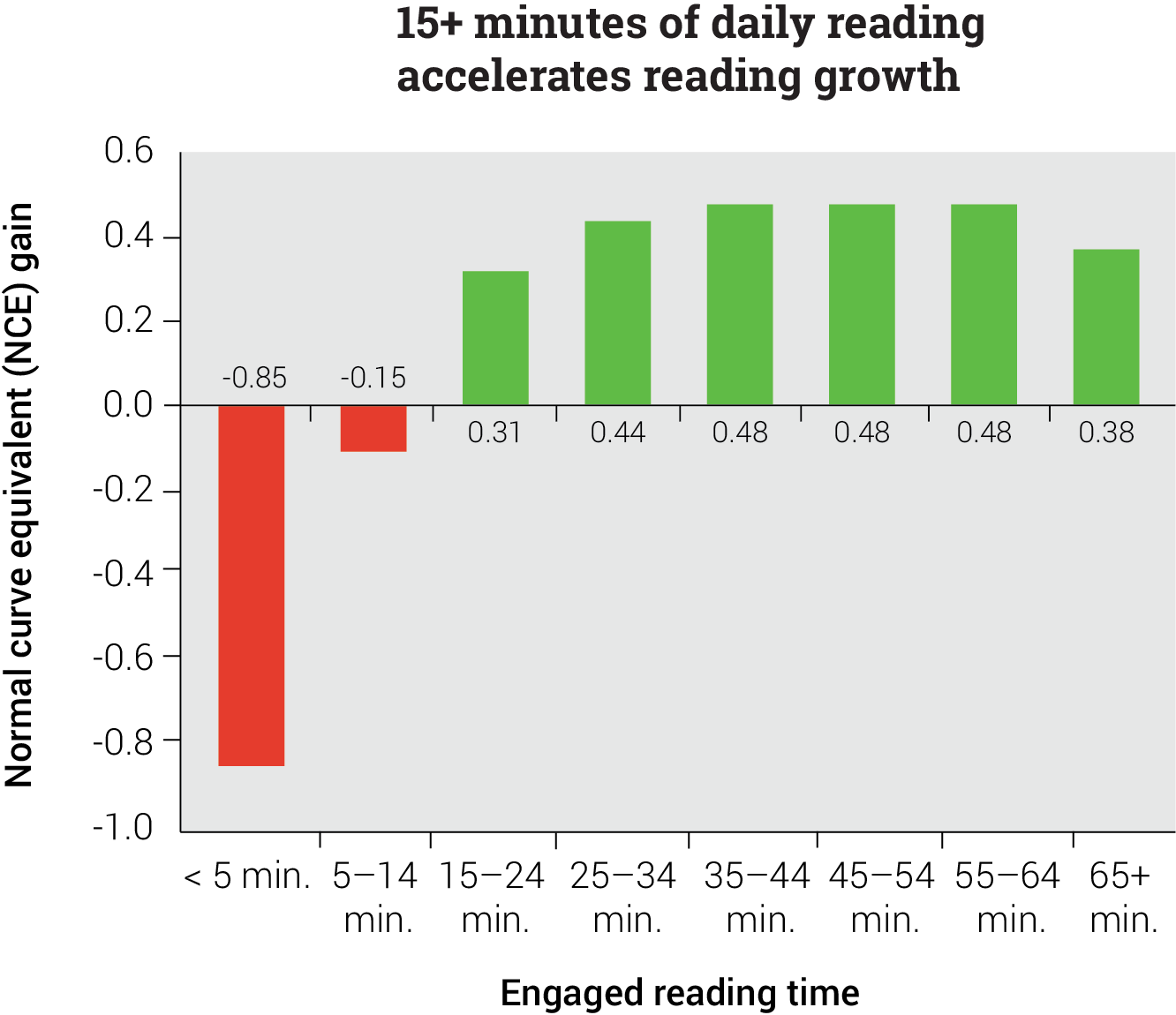
Although many other factors—such as quality of instruction, equitable admission to reading materials, and family background—also play a part in achievement, the consistent connection between fourth dimension spent reading per day and reading growth cannot be ignored.
Moreover, if reading practice is linked to reading growth and achievement, so it follows that low levels of reading practice should correlate to depression levels of reading performance and high levels of reading practice should connect to loftier levels of reading performance. This pattern is precisely what we run across in educatee exam data.
Strong connections between reading practice and accomplishment
An analysis of more than 174,000 students' Plan for International Student Cess (PISA) scores revealed that connection betwixt reading appointment and reading functioning was "moderately strong and meaningful" in all 32 countries examined, including the United States.3 On average, students who spent more time reading, read more than diverse texts, and saw reading equally a valuable activity scored higher on the PISA's combined reading literacy scale.
The written report as well plant a educatee'southward level of reading engagement was more highly correlated with their reading achievement than their socioeconomic status, gender, family unit structure, or time spent on homework. In fact, students with the lowest socioeconomic background only high reading date scored better than students with the highest socioeconomic groundwork but low reading engagement.
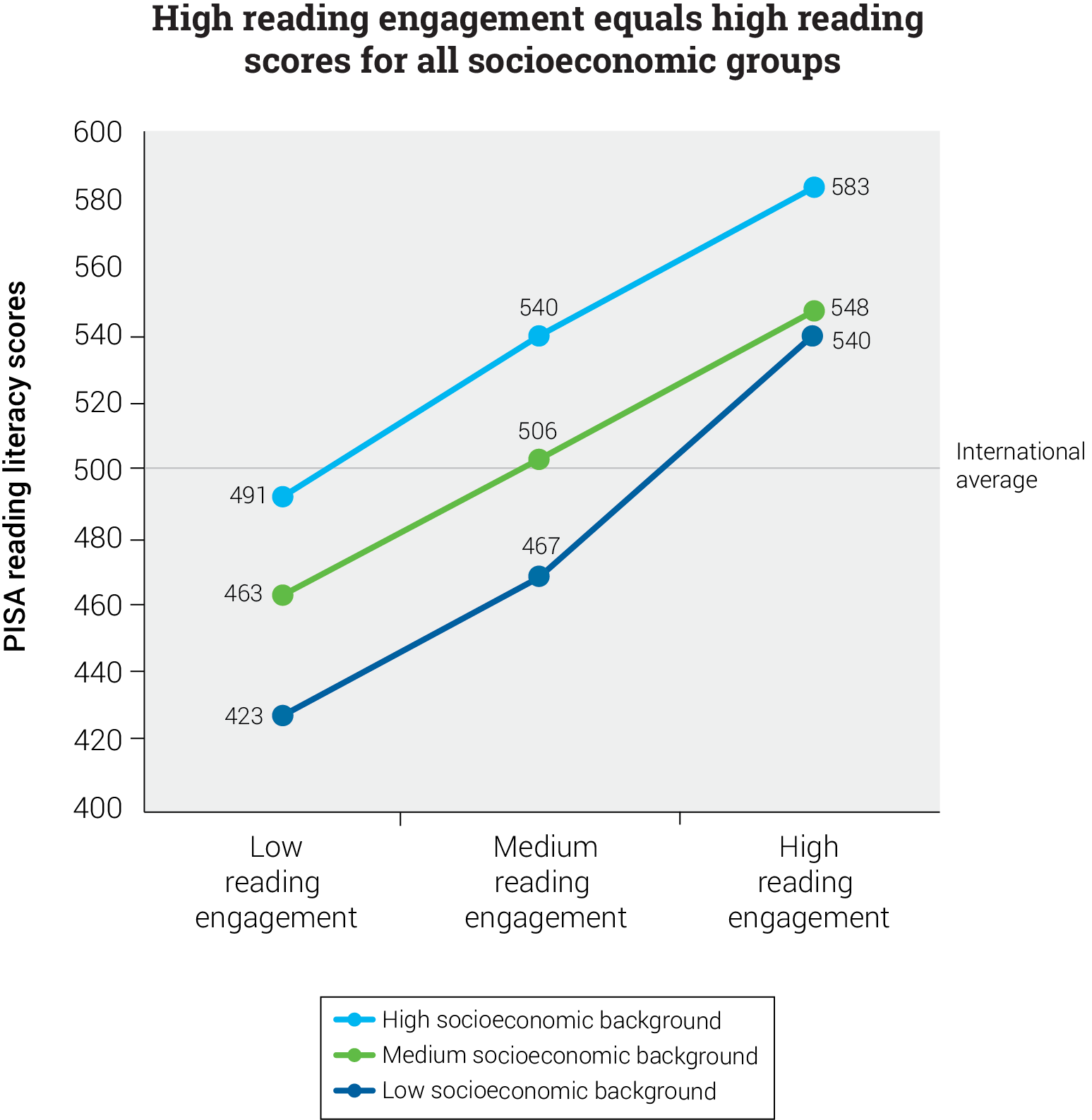
Overall, students with high reading appointment scored significantly to a higher place the international boilerplate on the combined reading literacy calibration, regardless of their family groundwork. The opposite was too true, with students with low reading engagement scoring significantly below the international average, no matter their socioeconomic status.
The authors suggested that reading do can play an "important function" in endmost achievement gaps between different socioeconomic groups. Frequent high-quality reading exercise may help children compensate for—and even overcome—the challenges of being socially or economically disadvantaged, while a lack of reading practice may erase or potentially contrary the advantages of a more privileged background. In short, reading practise matters for kids from all walks of life.
For students within the U.s., reading practice may not simply be more important than socioeconomic status—it may too be more than important than many school factors.
Looking at only American students' PISA scores, we run across that reading appointment had a college correlation with reading literacy achievement than time spent on homework, relationships with teachers, a sense of belonging, classroom surroundings, or even pressure level to achieve (which had a negative correlation). In addition, a regression analysis showed achievement went upwards across all measures of reading literacy performance when reading engagement increased.
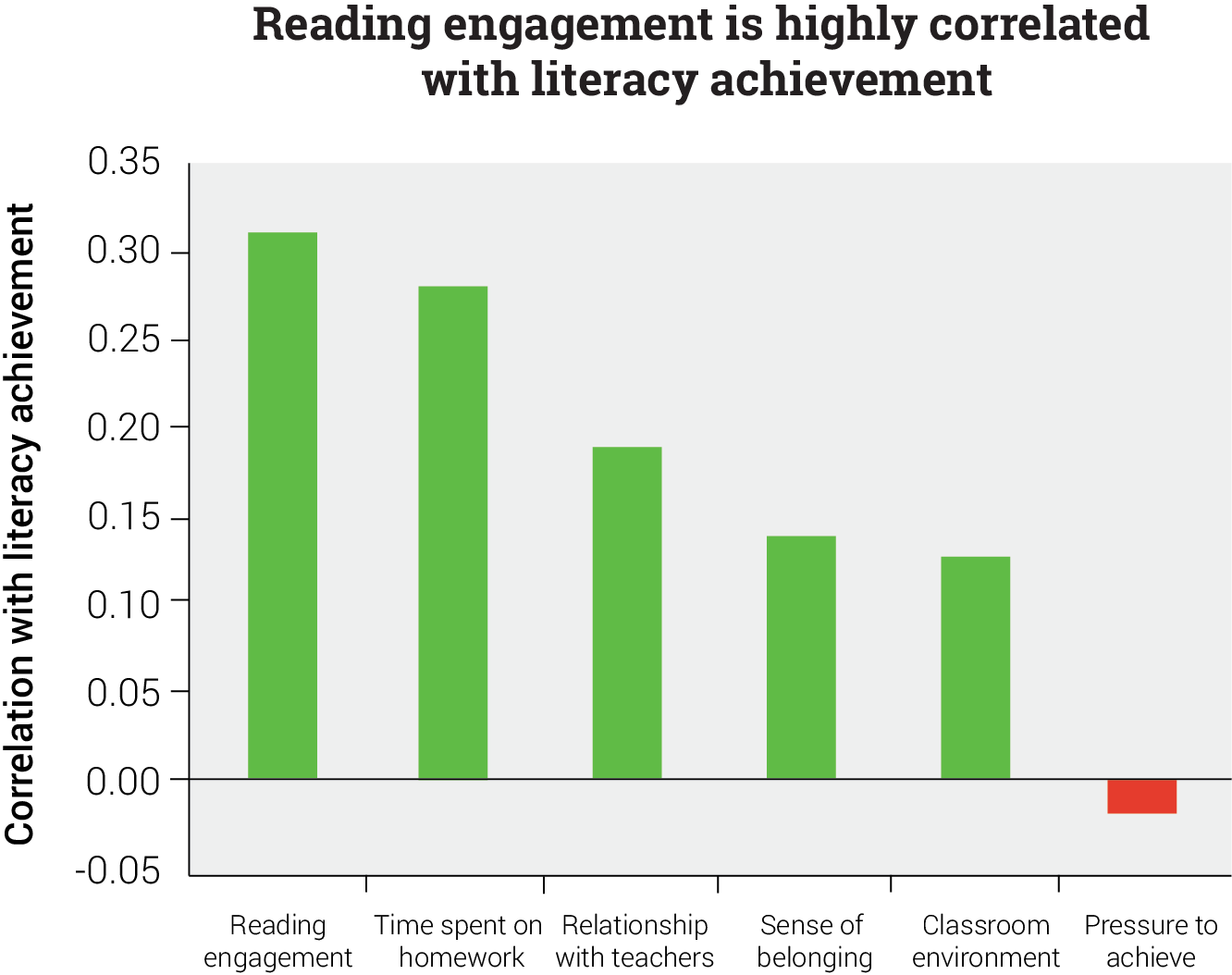
Although the PISA only assesses 15-year-olds, similar patterns can exist seen in both younger and older American students. In 2013, the National Center for Educational activity Statistics (NCES) compared students' National Assessment of Educational Progress (NAEP) reading scores with their reading habits.4 For all age groups, they found a clear correlation between the frequency with which students read for fun and their average NAEP scores: The more frequently students read, the higher their scores were.
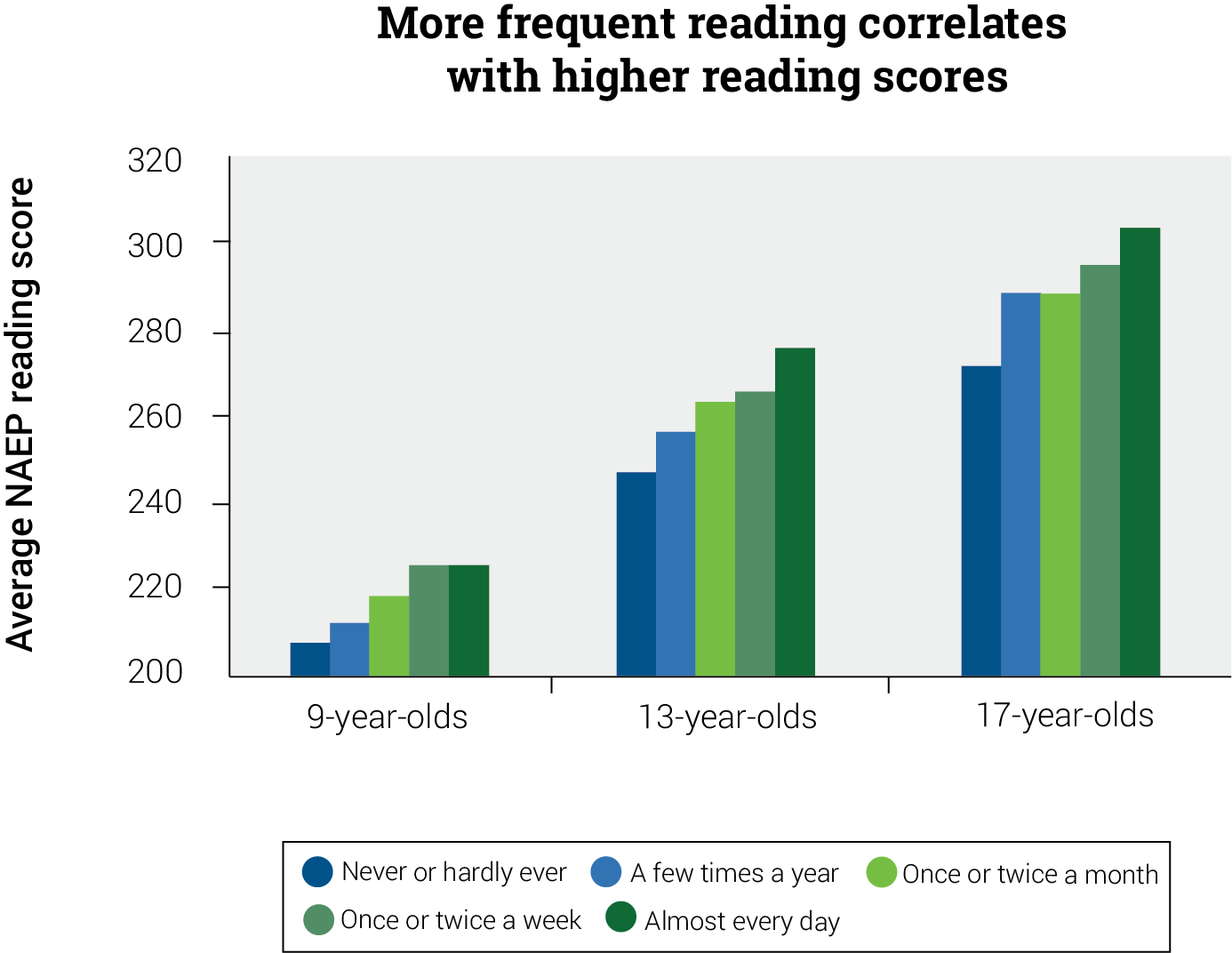
What is specially interesting about the NAEP results is that the correlation between reading frequency and reading scores was true for all age groups and the score gaps increased across the years. Amongst 9-yr-olds, there was simply an 18-point difference between children who reported reading "never or inappreciably ever" and those who read "almost every twenty-four hour period." Past age 13, the gap widened to 27 points. At historic period 17, information technology further increased to thirty points.
This seems to run contrary to the usually held wisdom that reading practice is near of import when children are learning how to read simply less essential once central reading skills have been acquired. Indeed, we might fifty-fifty hypothesize the reverse—that reading practice may grow more important every bit students move from form to form and encounter more challenging reading tasks. Until more enquiry either confirms or disproves this possible explanation, information technology is aught more than a guess, but an interesting one to consider nonetheless.
However, what is clear is that reading do is decreasing amid all age groups, with the most dramatic decreases among the very students who may need it the most.
Troubling declines in reading exercise
Over the last three decades, reading rates have dramatically declined in the United States. In 1984, NAEP results showed the vast majority of 9-twelvemonth-olds read for fun once or more per week, with more than than half reporting reading almost every day. Only ane in five reported reading two or fewer times per month. By 2012, 25% of all nine-year-olds were reading for pleasure fewer than 25 days per year.5
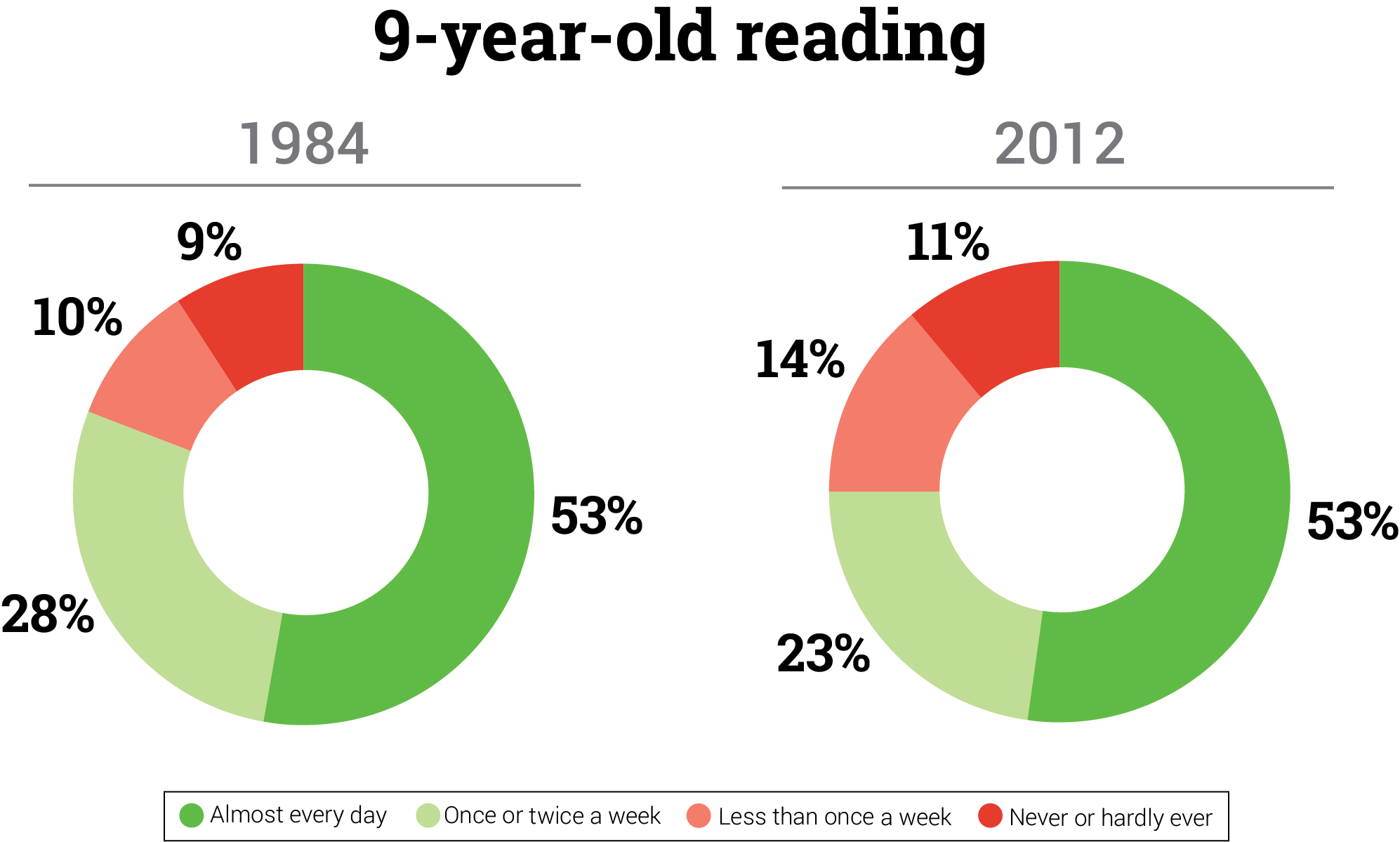
For older students, the driblet is even more precipitous. In 1984, 35% of xiii-yr-olds read for fun almost every twenty-four hours, and another 35% read one or two times per calendar week—in total, more than than two-thirds of 13-year-olds reported reading at least once a calendar week. In 2012, nearly one-half read less than once a week.
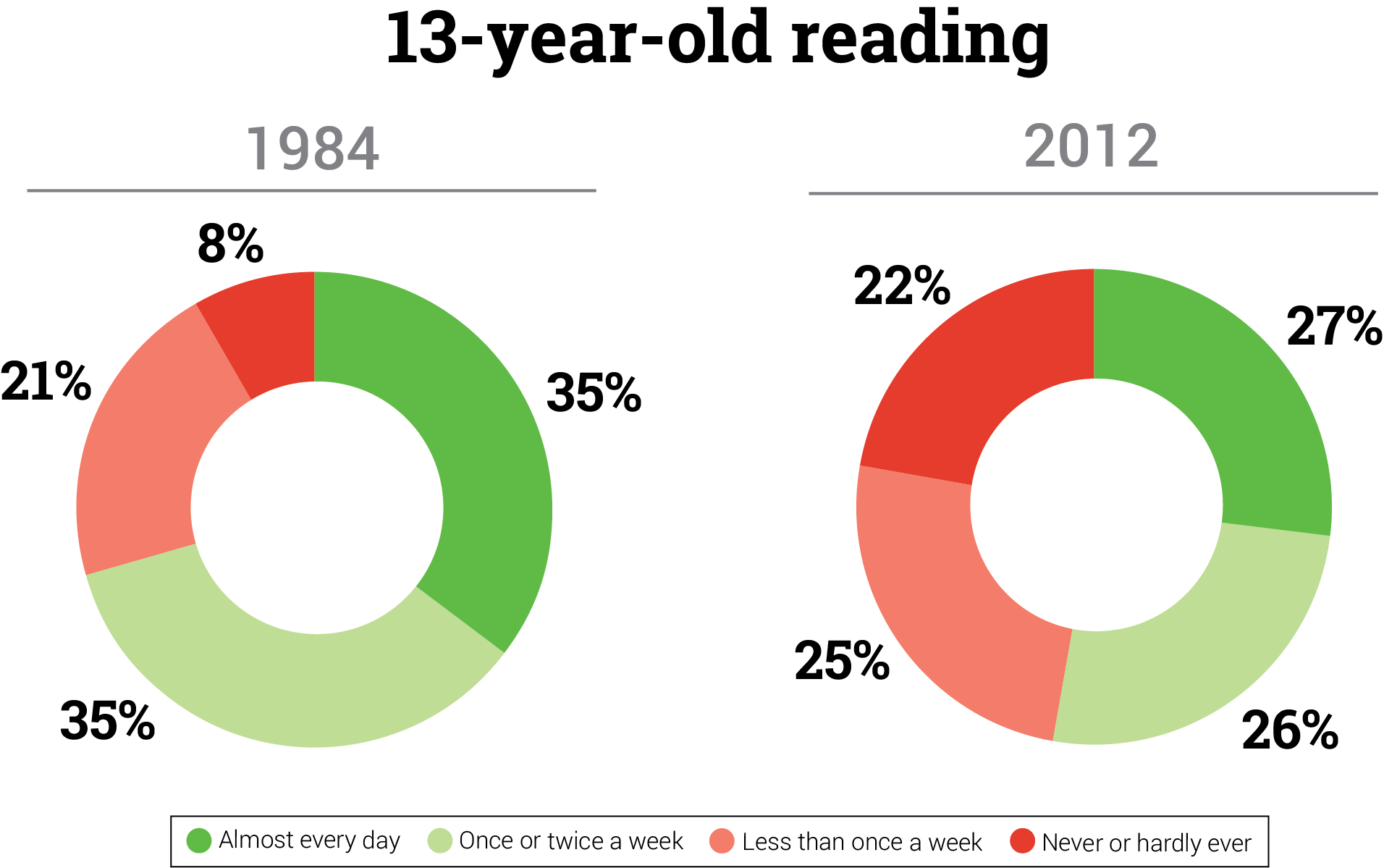
Among 17-year-olds, the pct reading about every twenty-four hours dropped from 31% in 1984 to only nineteen% in 2012, while the percentage who read for fun less than one time a week rose from 36% to 61%. The number of 17-year-olds reporting reading "never or hardly ever" actually tripled.
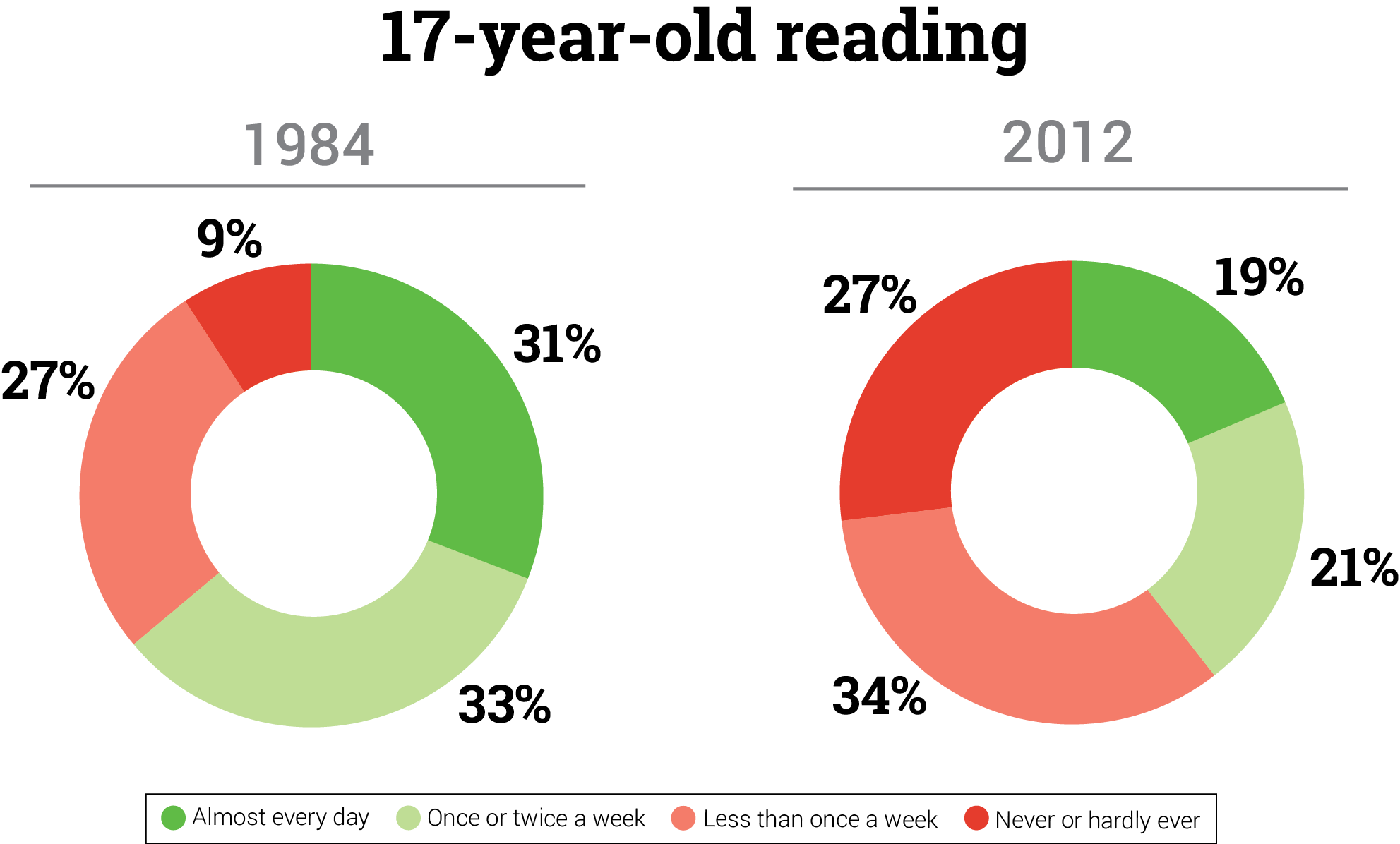
And the decline in reading is not due to students spending more than fourth dimension on homework in 2012 than in 1984. During the aforementioned time period, the percentage of students who reported spending more than an hour on homework actually declined.
In 1984, 19% of 9-year-olds, 38% of thirteen-year-olds, and forty% of 17-year-olds reported spending an hr or more on homework the day prior to the NAEP. In 2012, those numbers had dropped to 17% for ix-yr-olds, 30% for 13-year-olds, and 36% for 17-year-olds.
Why are we seeing the greatest gaps and the greatest declines in the oldest students? Although many different factors are likely at play, one of them might exist that the furnishings of reading practice are cumulative over a student'southward schooling, specially when it comes to vocabulary.
The long-term effects of reading practice
What'due south the difference between kids who read more 30 minutes per mean solar day and those who read less than 15 minutes per twenty-four hour period?
Twelve million.
Between kindergarten and twelfth grade, students with an average daily reading time of 30+ minutes are projected to see 13.vii meg words. At graduation, their peers who averaged less than 15 minutes of reading per twenty-four hours are likely to be exposed to but one.v million words. The deviation is more than 12 1000000 words. Children in between, who read 15–29 minutes per mean solar day, will encounter an average of 5.vii one thousand thousand words—less than one-half of the high-reading group but nearly 4 times that of the depression-reading group.1
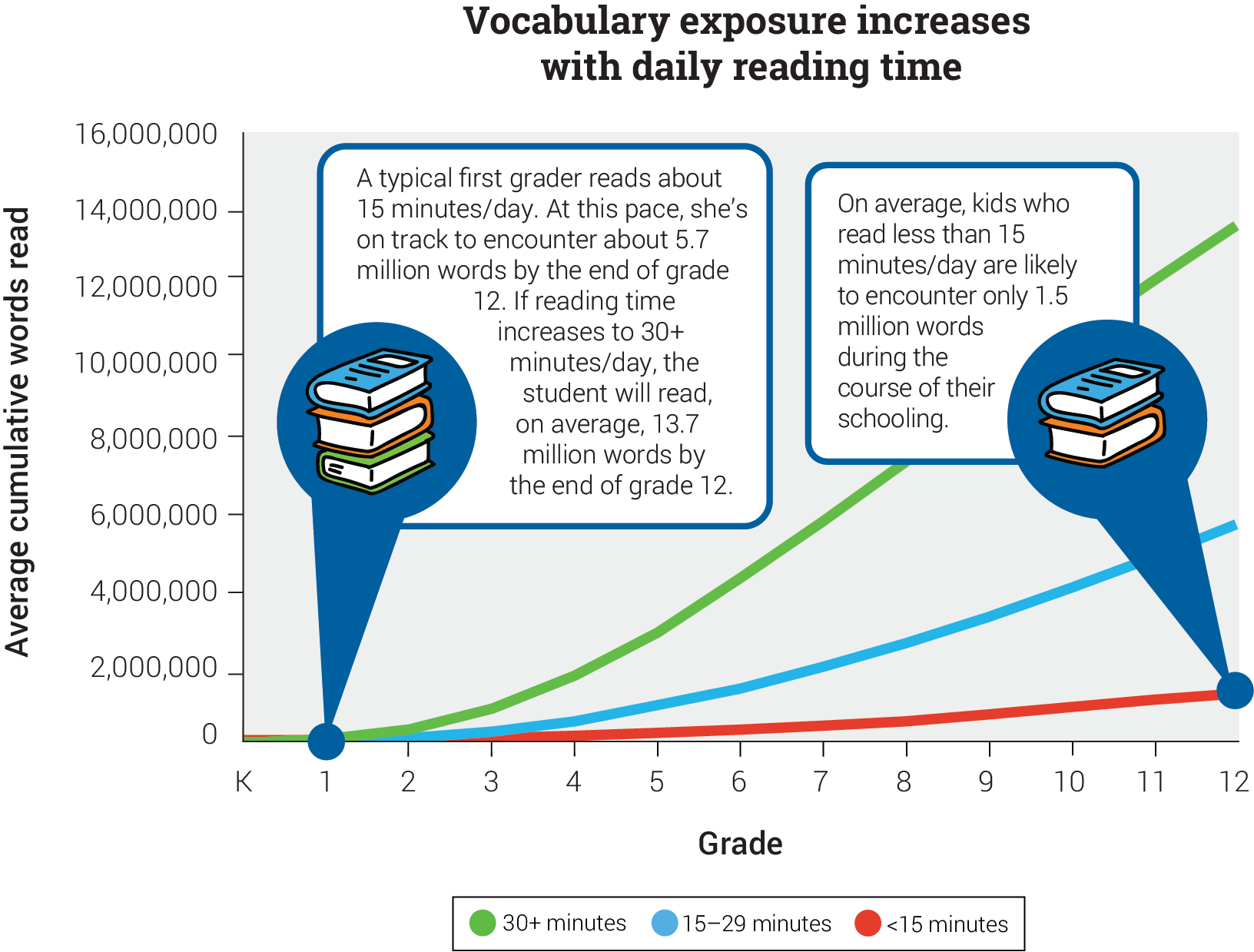
Some researchers estimate students learn one new discussion of vocabulary for every k words read.6 Using this ratio, a pupil who reads only ane.5 million words would learn only one,500 new vocabulary words from reading, while a student who reads 13.7 million words would acquire 13,700 new vocabulary terms—more than nine times the corporeality of vocabulary growth.
This is especially important when we consider that students can larn far more words from reading than from direct education: Fifty-fifty an aggressive schedule of 20 new words taught each week will result in merely 520 new words past the cease of the typical 36-calendar week school year. This does not mean that reading practice is "meliorate" than direct instruction for building vocabulary—direction instruction is key, simply teachers can only do so much of it. Instead, nosotros inquire educators to imagine the potential for vocabulary growth if direct instruction, structural assay strategies, and reading do are all used to reinforce one another.
Vocabulary plays a disquisitional role in reading achievement. Enquiry has shown that more than half the variance in students' reading comprehension scores can be explained by the depth and breadth of their vocabulary cognition—and these two vocabulary factors tin even exist used to predict a pupil's reading performance.7
We can see the human relationship between vocabulary and reading accomplishment clearly in NAEP scores, where the students who had the highest average vocabulary scores were the students performing in the acme quarter (above the 75th percentile) of reading comprehension. Similarly, students with the lowest vocabulary scores were those who were in the bottom quarter (at or below the 25th percentile) in reading comprehension.8 This means those boosted 12 million words could potentially have a huge impact on student success.
And so what are we to do, when reading exercise is and then conspicuously connected to both vocabulary exposure and reading accomplishment, just not enough students are getting enough reading practise to drive substantial growth?
The answer seems clear. Nosotros need to make increasing reading practice a top priority for all students in all schools. Making reading practice a system-broad objective may be i of the most important things we can do for our students' long-term outcomes, especially when we combine information technology with high-quality education and effective reading curricula. Information technology is time to put as much focus on reading practice as nosotros practice on school civilisation, student-educator relationships, and socioeconomic factors.
Yet, not all reading do is built the same. Quantity matters, simply so does quality. In the next post in this series, we explore how you lot can ensure your students are getting the nearly out of every minute of reading practice.
To read the next post in this series, click the imprint below.

References
1 Renaissance Learning. (2016). What kids are reading: And how they grow. Wisconsin Rapids, WI: Author.
2 Renaissance Learning. (2015). The research foundation for Accelerated Reader 360. Wisconsin Rapids, WI: Author.
three Kirsch, I., de Jong, J., Lafontaine, D., McQueen, J., Mendelovits, J., & Monseur, C. (2002). Reading for alter: Operation and engagement across countries: Results from PISA 2000. Paris, France: Organization for Economic Co-operation and Development (OECD).
4 National Center for Education Statistics. (2013). The nation'due south written report carte: Trends in academic progress 2012 (NCES 2013 456). Washington, DC: U.S. Department of Education Institute of Education Sciences.
5 National Center for Education Statistics. (2013). Table 221.30: Average National Assessment of Educational Progress (NAEP) reading scale score and percent distribution of students, by historic period, amount of reading for school and for fun, and time spent on homework and watching TV/video: Selected years, 1984 through 2012. Digest of Education Statistics. Washington, DC: U.S. Department of Education Institute of Education Sciences. Retrieved from: https://nces.ed.gov/programs/assimilate/d15/tables/dt15_221.30.asp
6 Mason, J.One thousand., Stahl, S. A. , Au, One thousand. H. , & Herman, P. A. (2003). Reading: Children's developing noesis of words. In J. Flood, D. Lapp, J. R. Squire, & J. M. Jensen (Eds.), Handbook of research on teaching the English language arts (2nd ed., pp. 914-930). Mahwah, NJ: Lawrence Erlbaum Associates.
7 Qian, D. D. (2002). Investigating the Human relationship Between Vocabulary Knowledge and Bookish Reading Performance: An Cess Perspective. Language Learning, 52(3), 513-536.
8 National Heart for Instruction Statistics. (2013). 2013 Vocabulary study. 2013 Reading cess. Washington, DC: U.Due south. Department of Instruction Institute of Education Sciences.
Source: https://www.renaissance.com/2018/01/23/blog-magic-15-minutes-reading-practice-reading-growth/
0 Response to "How Many Pages of Text Is 30 Min Reading Aloud"
Post a Comment